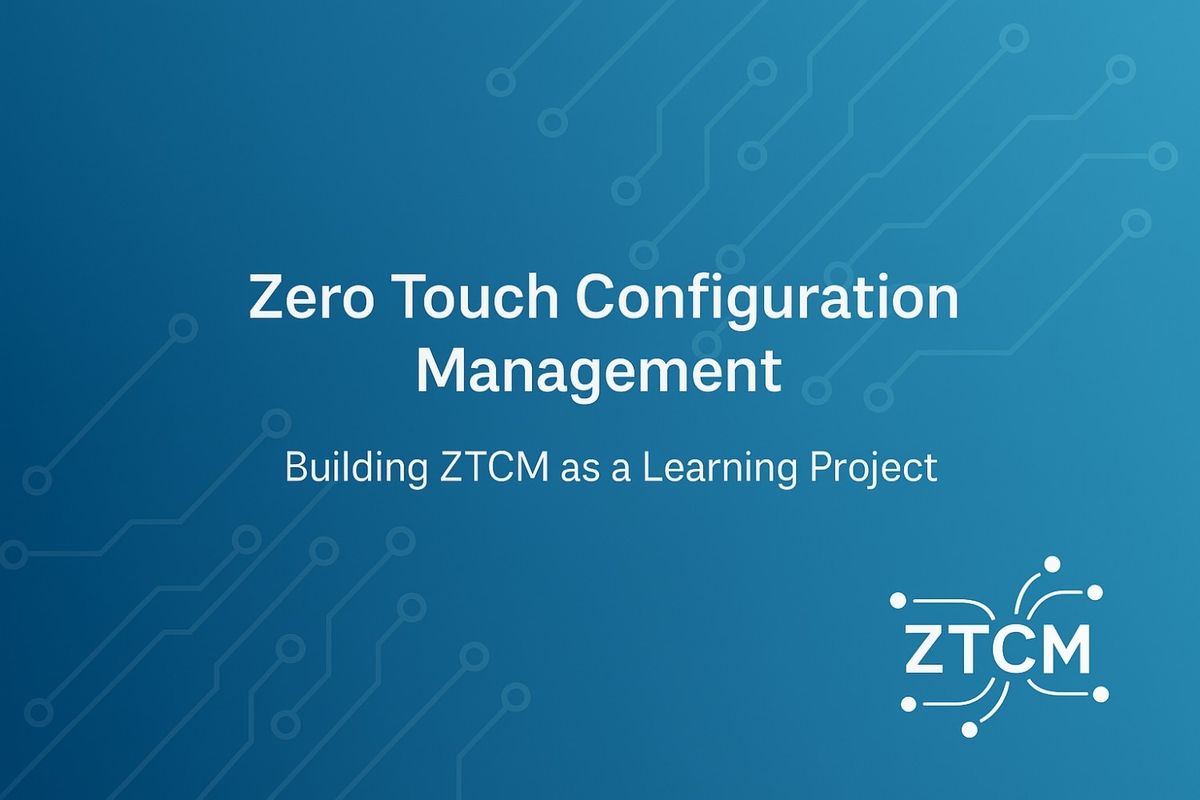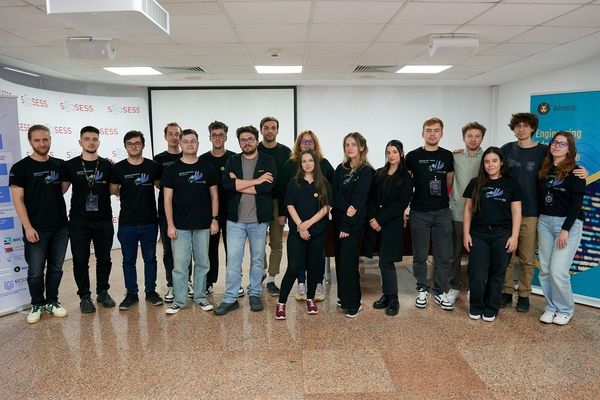ZTCM - Zero Touch Configuration Management

Highlights
ZTCM is a modular platform that automates configuration management for distributed edge and IoT devices. The platform reduces manual configuration tasks, speeds up deployment processes, and provides consistent security policies across device networks. ZTCM helps organizations in retail, manufacturing, logistics, and infrastructure manage their distributed devices more efficiently.
What ZTCM Does
- Automated device setup - Configure multiple devices without manual intervention
- Works with existing tools - Integrates with Keycloak, Ansible Tower, MongoDB, GitLab, and Teleport
- Reusable templates - Create configuration patterns once, use them repeatedly
- Security and tracking - Built-in access controls and detailed activity logs
- Flexible hosting - Deploy on cloud platforms, your own servers, or mixed environments
- Easy integration - Connect with existing IT management systems through APIs
- Real-time monitoring - Track device status and configuration compliance
1. What is Zero Touch Configuration?
How It Works
Zero Touch Configuration means devices can be set up and managed without manual steps during deployment or ongoing operations. The system handles device discovery, security authentication, configuration deployment, and status monitoring automatically.
The approach requires three main components: secure device identification using digital certificates, template-driven configuration using standard automation tools, and two-way communication between the management platform and devices for status updates and remote control.
Configuration templates contain all the settings a device needs including network parameters, security policies, and operational rules. These templates can include variables that change based on location or device type while keeping everything else consistent.
Where It's Useful
Manufacturing and Industrial Settings Factories deploy sensor networks that need identical configurations across production lines. Automated setup allows quick sensor replacement during maintenance without requiring specialized technicians on-site. Templates ensure all devices collect data the same way and follow the same security rules.
Retail and Edge Computing Stores, clinics, and transportation hubs use distributed computers that need standard configurations adapted to local network conditions. Automated deployment reduces setup time from hours to minutes while maintaining consistent security across all locations.
Network Equipment Management IT teams benefit from template-driven configuration that applies security policies, network settings, and service rules consistently. This approach reduces configuration mistakes and allows administrators to manage more devices with the same staff.
Remote Monitoring Applications Environmental monitoring, fleet tracking, and asset management systems need device configurations that vary by location while maintaining centralized data standards. Automation enables scaling these deployments without proportional increases in support staff.
2. How ZTCM Started
Managing distributed devices manually creates significant challenges for IT teams. When organizations deploy hundreds or thousands of IoT sensors, edge computers, or network devices across multiple locations, configuration becomes a bottleneck that slows operations and introduces errors.
The ZTCM project was developed as an academy learning initiative to address three key problems: the time-consuming nature of configuring devices individually, the difficulty of maintaining consistent security settings across all devices, and the need for centralized control without requiring technical staff at every location.
Research showed that existing solutions were either limited to specific vendors or too complex for many organizations. This created an opportunity to develop a flexible, straightforward approach to automated device configuration that works across different hardware types and deployment scenarios as a comprehensive learning project.
3. Building ZTCM as a Learning Project
Project Goals and Technical Learning
The ZTCM development served as a comprehensive learning initiative covering distributed system design, integration with existing tools, and automated configuration management. The project tackled real technical challenges while building practical experience with modern infrastructure management.
Learning objectives included implementing service-based architecture, designing secure communication protocols, optimizing databases for different data types, and integrating with existing authentication systems. These areas provided hands-on experience with production system development practices.
System Architecture
ZTCM uses a modular architecture that separates different functions like authentication, configuration management, task execution, and monitoring. This separation allows each part to scale independently based on demand while maintaining clear connections between components.
How the System Works
Users access the platform through a web interface that sends configuration requests to a request handler for validation and routing to the control center. The control center works with validation modules including marketplace and device verification components, while task execution happens through Ansible Tower integration.
All activities are tracked and recorded, with data stored in MongoDB and user authentication handled by Keycloak. Configuration scripts and templates are version-controlled in GitLab, while secure communication with remote devices uses Teleport tunneling and local agent software.
Development Process and Learning
The learning experience followed an step-by-step approach combining theoretical knowledge with practical implementation. Each development phase addressed specific technical challenges while building understanding of distributed system architecture.
Development started with single-server prototypes to validate core concepts, then moved to distributed architecture that introduced service communication and data consistency challenges. Later phases focused on integration requirements and deployment considerations.
Technical skills developed included container management, API design, database optimization, security implementation, and monitoring system integration. These skills align with industry requirements for infrastructure management platforms.
Technical Challenges and Solutions
Database design provided significant learning opportunities because different devices need different configuration parameters. This led to flexible document-based storage solutions rather than rigid table-based databases.
Authentication system integration revealed complexities in working with existing identity providers. Implementation required understanding security protocols and certificate-based authentication to support different organizational requirements.
Service communication introduced challenges in service discovery, load distribution, and error handling. The learning process involved implementing health monitoring, failure protection patterns, and distributed logging for system visibility.
Configuration template management required understanding variable replacement, template validation, and version control integration. These concepts connected software development practices with infrastructure automation requirements.
4. How ZTCM Can Be Used
Standalone Platform
ZTCM works as an independent device management solution for organizations that need comprehensive configuration control over distributed devices. Standalone deployment provides complete lifecycle management including device registration, configuration deployment, monitoring, and compliance reporting.
Infrastructure requirements include dedicated computing resources for control components, network connectivity to managed devices, and certificate authority integration for device authentication. Storage needs scale with device count and configuration complexity.
The platform supports device populations from hundreds to thousands of units, with performance scaling through horizontal component expansion and database optimization. Deployment time ranges from minutes for single devices to hours for large-scale updates.
Integration Tool
ZTCM connects with existing management platforms through standard APIs and notification interfaces. The platform can function as a specialized configuration component within larger IT management systems.
Development Pipeline Integration Configuration templates integrate with continuous integration pipelines for automated testing and deployment. GitLab integration enables version control workflows while notifications trigger configuration updates based on code changes.
IT Service Management The platform provides API endpoints for integration with IT service management platforms. Automated ticket creation captures configuration failures while status updates maintain visibility within existing management dashboards.
Network Management Integration Monitoring capabilities enable integration with network management platforms for centralized device status reporting. Configuration compliance checks integrate with security policy systems for automated correction workflows.
Deployment Options
Cloud Deployment Container management enables flexible scaling based on operational demands. Cloud provider integration supports managed database services and certificate management. Multi-region deployment provides geographic distribution for global device management.
Mixed Environment Cloud-based management console combines with on-premises execution components for organizations with data sovereignty requirements. Encrypted communication maintains security while enabling centralized management of distributed infrastructure.
On-Premises Deployment Local deployment supports environments with restricted network connectivity. Local certificate authority integration maintains security while offline capabilities enable configuration management during network outages.
5. Conclusion
ZTCM demonstrates how academy projects can address real-world operational challenges in distributed infrastructure environments. This learning initiative showcased practical approaches to automated device configuration management while developing expertise in distributed systems design.
The development process provided valuable insights into distributed systems design, secure communication protocols, and configuration management automation. Technical decisions regarding database selection, service-based architecture, and integration proved effective for the target use cases and demonstrated the potential for production implementation.
Platform capabilities developed through this academy project include significant reduction in configuration deployment time, elimination of manual configuration errors, and improved security through consistent policy application. The project demonstrates how educational initiatives can produce solutions with real operational value.
Future development could include machine learning integration for predictive configuration management, expanded device support for emerging IoT platforms, and enhanced integration capabilities with cloud-native management platforms. The modular architecture foundation developed during the academy program supports these enhancements without requiring fundamental redesign.
The ZTCM academy project establishes a foundation for understanding large-scale automation challenges while demonstrating practical solutions for modern device infrastructure management requirements through hands-on learning and development.




